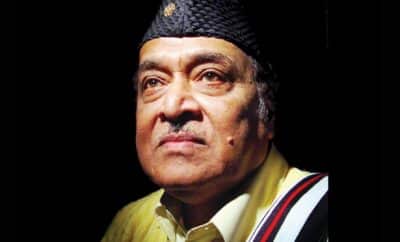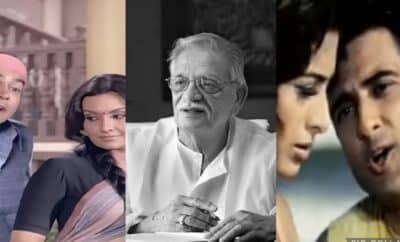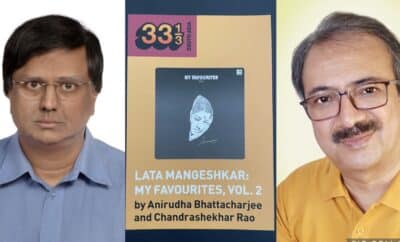Collections
A Paen on Piano
The first image that piano in hindi films churns up is a spacious set where chadeliers hang from the ceiling, tall pillars are brocaded with patterns, furnishings of the finest order are kept on the carpeted floor, bevy of beauties roam around and the protagonist caresses the keys with a song on his lips. The instrument is the symbol of beaux-mondes that mark them apart from the hoipoloi. The ambience flaunts elitist ways, a community of beaus and belles where only sophisticated gentries are allowed to sing and share their pains and pleasures. The transition from dreamy monochrome to eastman colour doesn’t bring any change to this ever popular motif of urban milieu soundscape. When there’s a grand ornate imposing wooden structure at the centrestage, notwithstanding the essential indian ethos of the movie, it immediately lends a style and a certain amount of inaccessibility for the common masses. After all playing piano the way silver screen heroes do, is never a common Indian’s vicarious wish fulfillment.
But there lies the trick of the dream peddlers. Hindi film heroes have the proverbial proficiency of playing whichever instrument they come across. And so being the cynosure of a gorgeous party they would nonchalantly pick up a saxophone and blow in the highest pitch effortlessly and at a single go take the pianist’s stool and let their fingers make music with equal elan. And on top of it there are the facial expressions of the most varied kinds to cover up all the lacunae that they by chance leave while playing.
Watching them play piano has always been fun to me. The songs of the 50s and 60s amused me a lot when the protagonist would keep flying his fingers on the keys in an elaborate movement but the prelude piano already gave way to tabla or sitar on the soundtrack. Sometimes piano would never be heard after initial bars but the hero keeps emoting sitting behind the grand piano almost throughout the song. Then if the same piano is heard in any interlude, he or she would be shifting his/her position by then to emote something else. But the most amusing filmic situation where piano came as a popular leitmotif was the instrument’s enviable ability of creating a personal melancholic space between two or three people among a roomful of giggling and totally indifferent partybugs. But there were sincere attempts of making a scene convincing and simmering with sentiments. I don’t know how my parents or grandparents reacted to those but I simply enjoy the scenes but (perhaps not the way) they were meant to be enjoyed. The tear jerking situations definitely didn’t call for a giggle from this insensitive soul of mine.
But one thing was for sure. The melody reigned supreme. The songs were nonpariel. Those picturisation may be in passe but the melody and the singing defy all tempero-spatial parameters. Let me go back and forth and let those tinkles on the reeds reverb in the mind once more.
(Disclaimer : The entire article is based only on my personal choice and interpretations. There can be thousand other opinions and i respect them sincerely. I picked up only where piano is seen on stage)
1. Piano to woo the fairer sex:-
Yea, I wonder if I ever visualised myself as an ambidextrous pianist to steal the hearts of ladies, drums were infinitely more potent medium I suppose, but when a debonair like Dharmendra sang Aap Ki Haseeb Rukh Pe Aaj Naya Noor Hain and a soft light catches the profile of two lovely ladies, wow, I bet, hindi films are all about these dreamy poetic expressions of love. The hyperbole of the Urdu lines, the outpouring of emotion by the great Md. Rafi and the soberness of the handsome hero simply floor the two ladies. Poetry, piano and monochrome make it awesome threesome.
I wonder whether there has been anyone of those monochrome days as magnetic as Dev Anand. Rebellious in his own right he would come up with the most unpredictable expressions where others just followed suit of their predecessors and contemporary trends. Defying the traditional diktats Dev just did what he did best- exuding his charms and making the leading ladies go weak kneed when a divine Kishore Kumar serenades Khwab Ho Tum Ya Koi Haqeeqat. Dev flashes his inimitable toothy grin while playing piano lines and eyes at the fairer sex the way only he could. Playfulness, innocence and sonority took the Dada Burman number in the highest pedestal.
In comes the first super star of the 70s. And when Junior Burman takes the baton of his father, Kishore Kumar pours out the elixir which only he has earned from heaven’s door. When Rajesh Khanna plays the extended piano on Pyar Diwana Hota Hai Mastana Hota Hai, it seats deeply in the enamoured heart of Asha Parekh.
https://youtu.be/lslZptXok8o
However progressive the digitised age in which we live, a synthesiser can’t even distantly replicate the aura that a piano used to have which we had witnessed decades back.
2. Piano that turned waiting sonorous:-
This theme has been a recurring one in those days. The hero will come to an unfamiliar place either by car or on horseback or simply walking through the flowery dale with a song in his lip. This desire to be loved found expression in piano either. Perhaps the most melodious example is Surekha Pandit’s Dheere Dheere Machal Aye Dil e Beqarar Koi Aa Jaye. This coincidences appear funny at times now as I am singing for someone and that person chooses that very time to make an entry. But these melodies are so sublime that cine goers willingly choose to suspend their rationality.
Another example is Sadhna playing piano and the Diva at her chirpiest best as she sings Kaun Aya Ke Nigahon Mein Chamak Jaag Uthi. This song is a rare one where piano playing is not picturised as anything redundant. Camera catches the nimble fingers on the reeds exactly when the sound is heard on the track. Another Waqt song Chehre Pe Khushi Cha Jati Hai echoes similar sentiment but I felt the lady in question sits like a mannequin behind the grand piano much unlike an animated Sadhna.
Let’s move forth to the day of the proverbial angry young man. Scopes of melodies shrunk to a considerable extent. But when Rakhee plays that beautiful piano tune on Dil To Hain Dil, the subtle desire puts on a philosophical apparel as well. The subjective pains and pangs here is objectified. Piano does leave a trail not only in the lovelorn heart of Amitabh but to us, as well.
3. Piano for the betrayed soul :–
This is perhaps the most oft-repeated filmic situation and it must have been the most effective ploy to send messages of a parched, burnt out soul. Plush sumptuous parties will take place at a critical juncture of a film. The erring and compunction-ridden heroines will be at the receiving end of highly peotic onslaughts from his one time lover. And the funny part is the presence of the third person of the triangle who either remains blissfully ignorant of the unpronounced vibes between his lady-love and her erstwhile lover or hangs a laconic smile at his supposed victory in the battle of love. Pran seemed to have bagged most number of roles in his tally where this insidious villainy of an intruder is concerned. Dilip Kumar’s Aaj Ki Raat Mere Dil Ki Salami Le Le was the poignant appeal that left Waheeda’s heart in pieces. Dilip Kumar was too graceful a person to wallow in self-pity. So he puts on a smile to declare how justice was unlawfully meted out to him.
Shammi Kapoor’s Dil Ki Jharokhe Mein Tujhko Bithakar is eponymous in this category. That is perhaps the most spontaneous choice. Who can accept the drumsticks weilding dasher of a hero who once played in Rocky band to sing sentimental weepy number? So the expression is of anger when he goes on flamboyant and forceful while playing piano and complaining against the betrayal. Rajyasree tries her best not to fall in the claptrap of sentimental lyrics but finally gives in. After all who can stay numbed (except ofcourse that insidious Pran) when poetry, piano and Shammi Kapoor’s terribly arching eyebrows make a fusillade of attacks!
https://youtu.be/7GS5QXBHsfU
However diabolical Pran wanted to look like, the inherent sophistication and class could never mark him to be a bad man. I may sound cruel to have liked Pran infinitely more than the weepy teary eyed Manoj Kumar in Patthar Ke Sanam. And where goes the piano in the soundtrack even if he keeps undulating his arms. But Md Rafi must have been providential to have offered the song to all the lovelorn men of that age.
To me, Shankar-Jaikishan would rank among the very best in songs on piano arrangement. In most of the cases piano is just another instrument. After piano transition, the eastern or typically indian arrangement of tabla-dholak takes over. But when I listen to Dost Dost Na Raha I feel almost entire song is on piano notes. The staccato lines of antara are the lyrical representation of piano. Same goes with the Bhramachari song. Same with Geet Gata Hoon Main of Lal Patthar. Sangam song on piano is unlike other songs having the same sentiment. It sounds much intense with only three people present and heaps of extras don’t crowd the elaborate set.
https://youtu.be/P5cbwArxCcI
I can’t help bringing my eternal favourite in the discussion and so let me refer to Dil Aj Shayar Hain. Piano is used just as a prop and thankfully Dev is not tortured to fake playing the instrument meaninglessly. The debonair Dev can’t simply suffer from self pity and when he is armed with a lethal force of Dada Burman and Kishore Kumar, he is simply unassailable.
Years after I happen to stumble over an Anu Malik song Is Tarah Ashiqui Ka and got a sense of deja vu minus that lyrical and musical bliss of the yesteryears.
4. Piano as the unifier of time:–
I admit my lack of knowledge so far the films of 50s and 60s on this category are concerned but 70 onwards there has been a plethora of instances and curiously enough junior Burman is the inevitable choice. May be Panchanda is the best to have bridged the glorious past and the present, a great blend of tradition and his own individual talent. The sad version of Tum Bin Jaun Kahan with Bharat Bhushan on piano is much unheard. And the reason is quite obvious of course. The tune keeps coming in refrain and Rd keeps on adding different flavours each time it is heard. But piano might have added the edge of an age in the protagonist’s character.
Raj Kapoor of Sangam becomes a grey old man in Dharam Karam. Among the variations of the epical Ek Din Bik Jayega, the piano version again stays under the shade. Mahalon Mein Ho Teri Bolo Ki Basti of Mukesh will be carried later by a cameo presentation of Kishore Kumar. Piano version is again associated with the age while Na Ho Bas Me Teri sounds more decorated with other instruments.
Does Shashi Kapoor sit beside piano more than anyone else? May be the blue blood in him and an essential gentility marks him to be the most sobered customer. Jahan Pe Savera Ho is a Lata vocal but the elaborate piano offers Shashi Kapoor wings to go back to past. The melee of crowd gets thinned out here. Shashi Kapoor’s piano is almost a soliloquy. It is much introspective and so is the lyrics of Gulzar Saab. The tune comes back in refrain and piano stays interlaced with all the memories of the past. Panchamda used piano as an agent to go back and forth in Yeh Waada Raha where the immortal tune of Tu Tu Hain Wahin on piano is heard in the background and the set looks like that of the 60s.
Shashi Kapoor’s piano in Suhani Chandni Raatein is another soliloquy sung within a very private space of his own. It comes back in a refrain and piano plays the keynote each time it is heard.
Finally the longest piano (arguably)in any hindi film song comes with Panchamda again when Rishi Kapoor plays the piano prelude of Jeevan Ke Din Chhote Sahi Hum Hain Bade Dilwale. That elaborate sumptuous set comes back but the piano is used as the unifier of time-time past and time present. That laconical Pran of the bygone era now becomes an affectionate father. He now sits behind the grand instrument and sings the tune while playing it on piano. Don’t you think that Pran Saab himself had a deja vu while playing piano in those gigantic set!
Panchamda’s use of piano as an essentially decorative and inseparable instrument comes in lot many songs. Thanks to the commonest theme of birthday parties and similar get togethers in hindi films, Panchamda made liberal use of piano to add a lilt to his compositions and to make a soundscape much urban and classy. Though Sajti Hain Yunhi Mehfil’s piano fillers didn’t take away the oriental earthy identity of the song, piano in the songs like Chhalkao Jhoom Ke and Aaj Ka Din Na Jane Kyun make it sound typically urban.
Let me conclude referring to a song where the ever juvenile Dev radiates his good old charm with his vehemently out of the beaten track expressions. Panchamda and Kishore Kumar bestow the best to the generation to come. Tabu, the harbinger of an unborn age plays piano and Dev spreads that unfailing joie de vivre with You Are My Darling Tu Hain Meri Jaan. R.D. Burman remained as the Last of the Mohicans before the juggernaut of digital age came and swamped away the grand old acoustic instrument in its enormous waves. But when a city dweller tries to soothe his frayed nerves only a You Tube key opens up that world which the dream peddlers conjured up ages back and which still keep opening up vistas of dreams. I look back and let the unseen piano of Hum Aapki Ankhon Mein Is Dilko Basa De To resonate in my soul to trudge in for one more modern day existence.
https://youtu.be/dOeVRaV-UHw




Ajay
September 6, 2019 at 1:31 pm
“DHARTI KAHE PUKAR KE” (1969)
Music:- Laxmikant-Pyarelal Singer:- Lata Mangeshkar. Lyricist:- Majrooh Sultanpuri
This beautiful “WALTZ” rhythm with melodious tune.The song is beautifully decorated with use of PIANO and mellifluous SYMPHONY style VIOLINS…Lata Mangeshkar is simply outstanding, giving justification for this GEM of composition. The perfect song for DIWALI occasion. The song is filmed on Nivedita (Libi Rana) and Sanjeev Kumar.
https://www.youtube.com/watch?v=M-TbVDuoMKs
Ajay
September 6, 2019 at 1:41 pm
– Jo Unki Tamanna Hai Barbad Ho Ja “Intequam” 1968, Rafi/Rajendra Krishna/Laxmikant-Pyarelal.
A classic song. Just close your eyes and feel the fragrance & elegance of eternal voice of Rafi Saab. Beautifully orchestrated on PIANO with mesmerizing DHOLAK rhythm. The “interludes” have designed by instrumenting solo VIOLIN, SYMPHONY style VIOLINS and PIANO. Sanjay Khan looks smart. Sadhana and Anju Mahendru look charming.
ajay
September 6, 2019 at 1:42 pm
“MERE HAMDAM MERE DOST” 1968
Singer Mohammad Rafi / Lyricist Majrooh Sultanpuri
— Hui Sham Unka Khayal Aa Gaya
It’s beautifully sung by the inimitable Rafi Saab, and picturised on a lonely Dharmendra as he wanders through his home, glass in hand, bemoaning the faithlessness of his beloved. “Prelude” is full of SAXOPHONE and PIANO with other western instruments, sets the mood of the song. A mesmerizing composition and mellifluous orchestra arrangements. Entire song is woven around the glimpses of SAXOPHONE, ACOUSTIC GUITAR & CLARINET. In all the “interludes”. Overlapping sound effect of SAXOPHONE/CLARINET with PIANO is just brilliant. VIOLA , GUITAR, CELLOS and VIOLINS are also brilliantly executed in entire song. Another beauty of the song is it’s “ rhythm” DHOLAK / TABLA are used only in “antara”…all the “interludes:” are without any rhythm but just ear-pleasing.
Ajay
September 6, 2019 at 1:54 pm
Few More #LaxmikantPyarelal compositions on PIANO
.Jo Unki Tamanna Hai …Rafi..Intequam 1968
.Hui Sham Unka Khayal …Kishore..Mere Hamdam Mere Dost 1968
.Diye Jalaye Pyar Ke…Lata..Dharti Kahe Pukar Ke 1968
.Dhadkan Zara Ruk Gayi Hai…Suresh Wadkar…Prahar 1991
and many more.
Dinesh Ghate
September 7, 2019 at 12:01 am
Madhuban Khushboo Deta Hai
https://www.youtube.com/watch?v=ZPT-rm0C0WE
Piano Played By Bridget Carvalho
Tera Jaana Dil Ke Armaano Ka
https://www.youtube.com/watch?v=URfoTtyxOdU
Piano Played by Robbert Correa
H Ravikumar Puranam
September 7, 2019 at 11:07 am
Tum apan ranj o gham apni pareshni mjuhe dedo from khayyam from Shagoon
Jeet hi lenge baazi hum tum khel adhoora choota na again Khayyam from Shola hur shabnam
Geet Gata hoon mai muskurata hoon mai Shankar Jaikishan from Lal Patthar
Main Khush Naseeb Hoon Mujhko kisi ka pyar mila Ravi from Tower House
Tum Bin Jaaoon Kahan (sad version of Mohd. Rafi) R D Burman from Pyar ka Mausam
bequaraar e dil tu gaye jaa Kishore Kumar from Door ka Raahi
Koyi sone ka dil wala koi chandi ka dilwale Salil Choudhury from Maya and many many more
Vinay Hegde
September 7, 2019 at 2:54 pm
It must be mentioned here that Dilip Kumar had four piano songs in one single movie – Andaz (1949)